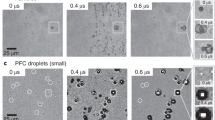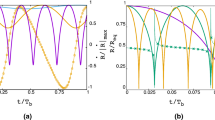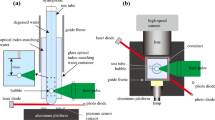Abstract
We use high-speed imaging to observe the dynamics of cavitation, caused by the impact and subsequent rebound of a sphere from a solid surface covered with a thin layer of highly viscous liquid. We note marked qualitative differences between the cavitation structures with increase in viscosity, as well as between Newtonian and non-Newtonian liquids. The patterns observed are quite unexpected and intricate, appearing in concentric ring formations around the site of impact. In all cases, we identify a distinct radius from which the primary bubbles emanate. This radius is modelled with a modified form of Hertz contact theory. Within this radius, we show that some fine cavitation structure may exist or that it may be one large cavitation bubble. For the non-Newtonian fluids, we observe foam-like structures extending radially with diminishing bubble sizes with increase in radial position. Whereas for the Newtonian fluids, the opposite trend is observed with increasing bubble size for increasing radial position. Finally, we compare our experimental observations of cavitation to the maximum tension criterion proposed by Joseph (J Fluid Mech 366:367–378, 1998) showing that this provides the lower limit for the onset of cavitation in our experiments.





















Similar content being viewed by others
References
Ardekani AM, Joseph DD, Dunn-Rankin D, Rangel RH (2009) Particle-wall collision in a viscoelastic fluid. J Fluid Mech 633:475–483
Ashmore J, Del Pino C, Mullin T (2005) Cavitation in a lubrication flow between a moving sphere and a boundary. Phys Rev Lett 94:124501
Barnocky G, Davis RH (1988) Elastohydrodynamic collision and rebound of spheres—experimental verification. Phys Fluids 31:1324–1329
Davis RH, Serayssol J-M, Hinch EJ (1986) The elastohydrodynamic collision of two spheres. J Fluid Mech 163:479–497
Davis RH, Rager DA, Good BT (2002) Elastohydrodynamic rebound of spheres from coated surfaces. J Fluid Mech 468:107–119
Donahue CM, Hrenya CM, Davis RH, Nakagawa KJ, Zelinskaya AP, Joseph GG (2010) Stokes’ cradle: normal three-body collisions between wetted particles. J Fluid Mech 650:479–504
Joseph DD (1998) Cavitation and the state of stress in a flowing liquid. J Fluid Mech 366:367–378
Kantak AA, Davis RH (2004) Oblique collisions and rebound of spheres from a wetted surface. J Fluid Mech 509:63–81
Kantak AA, Hrenya CM, Davies RH (2009) Initial rates of aggregation for dilute, granular flows of wet (cohesive) particles. Phys Fluids 21:023301
Kuhl T, Ruths M, Chen Y, Israelachvili (1994) J. Direct visualisation of cavitation and damage in ultrathin liquid films. J Heart Valve Dis 3(suppl. I):117–127
Landau LD, Lifshitz EM (1986) Theory of elasticity, 3rd edn. Butterworth-Heinemann, Oxford
Lian G, Adams MJ, Thornton C (1996) Elastohydrodynamic collisions of soft spheres. J Fluid Mech 311:141–152
Lian G, Xu Y, Huang W, Adams MJ (2001) On the squuze flow of a power-law fluid between rigid spheres. J Non-Newt Fluid Mech 100:151–164
Marston JO, Yong W, Thoroddsen ST (2010) Direct verification of the lubrication force on a sphere travelling through a viscous film upon approach to a solid wall. J Fluid Mech 655:515–526
Prokunin AN, Slavin RV (2006) Cavitation-induced particle-wall interactions in Newtonian and non-Newtonian fluids. Rheol Acta 45:348
Salman AD, Hounslow MJ, Seville JPK (eds) (2006) Handbook of powder technology, vol11: granulation. Elsevier, Amsterdam
Seddon JRT, Mullin T (2008) Cavitation in anisotropic fluids. Phys Fluids 20:023102
Williams PR, Williams RL (2002) Cavitation of liquids under dynamic stressing by pulses of tension. J Phys D Appl Phys 35:2222–2230
Yang L, Seddon JRT, Mullin T, Del Pino C, Ashmore J (2006) The motion of a rough particle in a Stokes flow adjacent to a boundary. J Fluid Mech 557:337–346
Acknowledgments
This work was initiated while W. Yong was attached to ICES from NUS during an undergraduate industrial attachment scheme under J.O. Marston. The work was supported by the Science and Engineering Research Council of A*STAR (Agency for Science, Technology and Research), Singapore. The authors would like to thank Ng Junwei for technical support and Professors T.G. Etoh & K. Takehara at Kinki University for use of their laboratory for some early experiments in this work.
Author information
Authors and Affiliations
Corresponding author
Electronic supplementary material
Below is the link to the electronic supplementary material.
Rights and permissions
About this article
Cite this article
Marston, J.O., Yong, W., Ng, W.K. et al. Cavitation structures formed during the rebound of a sphere from a wetted surface. Exp Fluids 50, 729–746 (2011). https://doi.org/10.1007/s00348-010-0979-9
Received:
Revised:
Accepted:
Published:
Issue Date:
DOI: https://doi.org/10.1007/s00348-010-0979-9




